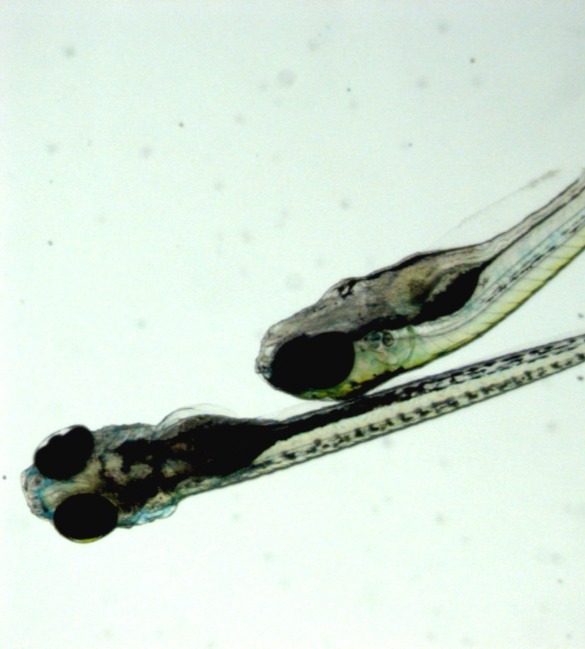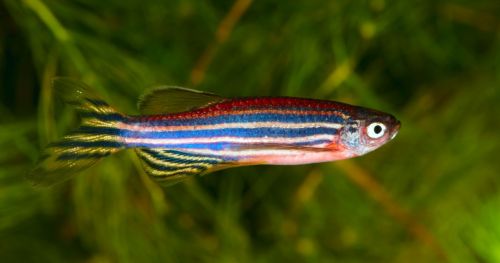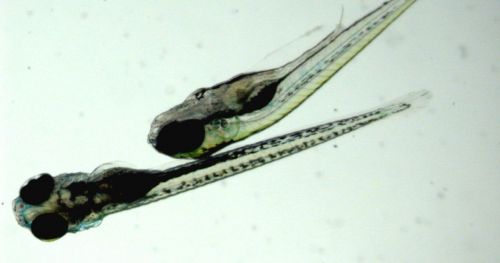Tools for
Optogenetics in zebrafish
Optogenetics allow scientists to control the activity of specific neurons and study their downstream influence on a variety of biological processes, including behavior. In rodent studies this technique requires optical fiber implantation, but as they are transparent, fiber optics are not needed in studies with zebrafish larvae. Light simply needs to shine in the right direction, making it easy to study the role of specific neurons in behavior.

Optogenetics and zebrafish larvae
By inserting light-sensitive receptor proteins into neurons in vivo, scientists are able to make these neurons sensitive to activation by light of specific wavelengths.
In zebrafish studies, the light-sensitive receptor protein halorhodopsin (NpHR) has successfully been used to inhibit swimming behavior in zebrafish larvae (Arrenberg, et al., 2009). Other research showed that channelrhodopsin-2 (ChR2) activation induced backward swimming in a sparse transgene expression line (Zhu et al., 2009).

Controlled environment
Application of optogenetic stimulation in zebrafish larvae does not require fiber optics, but it does require the correct wavelength (color) of light. When using the DanioVision Observation Chamber, the Optogenetics Add-on provides a way to accurately control and precisely time the application of optogenetic stimulation to up to 96 individuals simultaneously (working with 96 well plates).
Zebrafish research with DanioVision
Larvae activity and movement patterns are basic measurements used in many studies. They can reveal information on stereotypic and epileptic behaviors, circadian rhythmicity, motor control, movement disorders, neural development, and more.
DanioVision is a complete system designed for exactly these types of experiments with zebrafish larvae, and is often used in studies related to drug development, safety pharmacology, behavioral genetics, and circadian rhythmicity.
References
- Arrenberg, A.B.; Del Bene, F.; Baier, H. (2009). Optical control of zebrafish behavior with halorhodopsin. Proceedings of the National Academy of Sciences of the United States of America, 106, 17968-17973.
- Del Bene, F.; Wyart, C. (2012). Optogenetics: A new enlightenment age for zebrafish neurobiology. Developmental Neurobiology, 72(3), 401-414.
- Portugues, R.; Severi, K.E.; Wyart, C.; Ahrens, M.B. (2013). Optogenetics in a transparent animal: circuit function in the larval zebrafish. Current Opinion in Neurobiology, 23(1), 119-126.
- Simmich, J.; Staykov, E.; Scott, E. (2012). Zebrafish as an appealing model for optogenetic studies. Progress in Brain Research, 196, 145-162.
- Wyart, C.; Del Bene, F. (2011). Let there be light: zebrafish neurobiology and the optogenetic revolution. Reviews in the Neurosciences, 22(1), 121-130.
- Zhu, P.; Narita, Y.; Bundschuh, S.T.; Fajardo, O.; Scharer, Y.P.; Chattopadhyaya, B.; Bouldoires, E.A.; Stepien, A.E.; Desseroth, K.; Arber, S.; Sprengel, R.; Rijli, F.M.; Friedrich, R.W. (2009). Optogenetic dissection of neuronal circuits in zebrafish using viral gene transfer and the Tet system. Frontiers in Neural Circuits, 3, 21.
Relevant blogs

How young zebrafish cope with stress
Stress is a natural thing, and how we cope with it differs from person to person. In research, we use the term coping style, something that emerges early on in life for zebrafish.
 English
English German
German French
French Italian
Italian Spanish
Spanish Chinese
Chinese